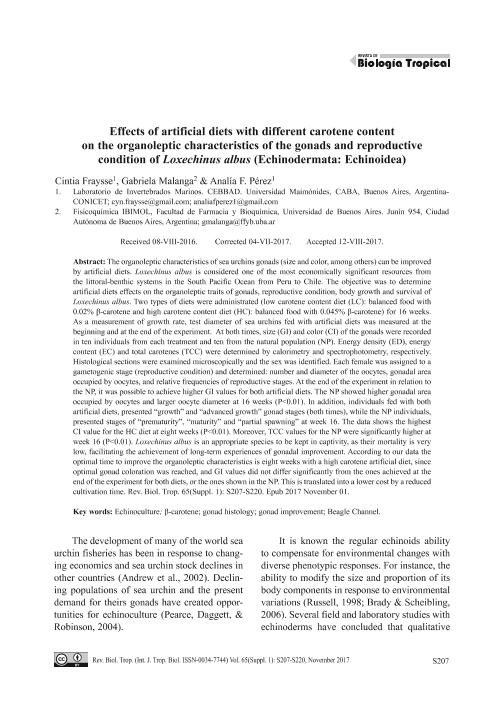Mostrar el registro sencillo del ítem
dc.contributor.author
Fraysse, Cintia Pamela

dc.contributor.author
Malanga, Gabriela Fabiana

dc.contributor.author
Pérez, Analía Fernanda

dc.date.available
2018-07-25T19:42:44Z
dc.date.issued
2017-06
dc.identifier.citation
Fraysse, Cintia Pamela; Malanga, Gabriela Fabiana; Pérez, Analía Fernanda; Effects of artificial diets with different carotene content on the organoleptic characteristics of the gonads and reproductive condition of Loxechinus albus (Echinodermata: Echinoidea); Universidad de Costa Rica; Revista de Biología Tropical; 65; 1; 6-2017; S207-S220
dc.identifier.issn
0034-7744
dc.identifier.uri
http://hdl.handle.net/11336/53129
dc.description.abstract
The organoleptic characteristics of sea urchins gonads (size and color, among others) can be improved by artificial diets. Loxechinus albus is considered one of the most economically significant resources from the littoral-benthic systems in the South Pacific Ocean from Peru to Chile. The objective was to determine artificial diets effects on the organoleptic traits of gonads, reproductive condition, body growth and survival of Loxechinus albus. Two types of diets were administrated (low carotene content diet (LC): balanced food with 0.02% β-carotene and high carotene content diet (HC): balanced food with 0.045% β-carotene) for 16 weeks. As a measurement of growth rate, test diameter of sea urchins fed with artificial diets was measured at the beginning and at the end of the experiment. At both times, size (GI) and color (CI) of the gonads were recorded in ten individuals from each treatment and ten from the natural population (NP). Energy density (ED), energy content (EC) and total carotenes (TCC) were determined by calorimetry and spectrophotometry, respectively. Histological sections were examined microscopically and the sex was identified. Each female was assigned to a gametogenic stage (reproductive condition) and determined: number and diameter of the oocytes, gonadal area occupied by oocytes, and relative frequencies of reproductive stages. At the end of the experiment in relation to the NP, it was possible to achieve higher GI values for both artificial diets. The NP showed higher gonadal area occupied by oocytes and larger oocyte diameter at 16 weeks (P<0.01). In addition, individuals fed with both artificial diets, presented “growth” and “advanced growth” gonad stages (both times), while the NP individuals, presented stages of “prematurity”, “maturity” and “partial spawning” at week 16. The data shows the highest CI value for the HC diet at eight weeks (P<0.01). Moreover, TCC values for the NP were significantly higher at week 16 (P<0.01). Loxechinus albus is an appropriate species to be kept in captivity, as their mortality is very low, facilitating the achievement of long-term experiences of gonadal improvement. According to our data the optimal time to improve the organoleptic characteristics is eight weeks with a high carotene artificial diet, since optimal gonad coloration was reached, and GI values did not differ significantly from the ones achieved at the end of the experiment for both diets, or the ones shown in the NP. This is translated into a lower cost by a reduced cultivation time.
dc.format
application/pdf
dc.language.iso
eng
dc.publisher
Universidad de Costa Rica
dc.rights
info:eu-repo/semantics/openAccess
dc.rights.uri
https://creativecommons.org/licenses/by-nc-sa/2.5/ar/
dc.subject
Echinoculture
dc.subject
B-Carotene
dc.subject
Gonad Histology
dc.subject
Gonad Improvement
dc.subject
Beagle Channel
dc.subject.classification
Otras Ciencias Biológicas

dc.subject.classification
Ciencias Biológicas

dc.subject.classification
CIENCIAS NATURALES Y EXACTAS

dc.title
Effects of artificial diets with different carotene content on the organoleptic characteristics of the gonads and reproductive condition of Loxechinus albus (Echinodermata: Echinoidea)
dc.type
info:eu-repo/semantics/article
dc.type
info:ar-repo/semantics/artículo
dc.type
info:eu-repo/semantics/publishedVersion
dc.date.updated
2018-06-28T16:32:27Z
dc.journal.volume
65
dc.journal.number
1
dc.journal.pagination
S207-S220
dc.journal.pais
Costa Rica

dc.journal.ciudad
Turrialba
dc.description.fil
Fil: Fraysse, Cintia Pamela. Universidad Maimónides. Área de Investigaciones Biomédicas y Biotecnológicas. Centro de Estudios Biomédicos, Biotecnológicos, Ambientales y de Diagnóstico; Argentina. Consejo Nacional de Investigaciones Científicas y Técnicas; Argentina
dc.description.fil
Fil: Malanga, Gabriela Fabiana. Consejo Nacional de Investigaciones Científicas y Técnicas. Oficina de Coordinación Administrativa Houssay. Instituto de Bioquímica y Medicina Molecular. Universidad de Buenos Aires. Facultad Medicina. Instituto de Bioquímica y Medicina Molecular; Argentina
dc.description.fil
Fil: Pérez, Analía Fernanda. Universidad Maimónides. Área de Investigaciones Biomédicas y Biotecnológicas. Centro de Estudios Biomédicos, Biotecnológicos, Ambientales y de Diagnóstico; Argentina. Consejo Nacional de Investigaciones Científicas y Técnicas; Argentina
dc.journal.title
Revista de Biología Tropical

dc.relation.alternativeid
info:eu-repo/semantics/altIdentifier/url/https://revistas.ucr.ac.cr/index.php/rbt/article/view/31689
dc.relation.alternativeid
info:eu-repo/semantics/altIdentifier/doi/https://doi.org/10.15517/rbt.v65i1%20-%201.31689
Archivos asociados
